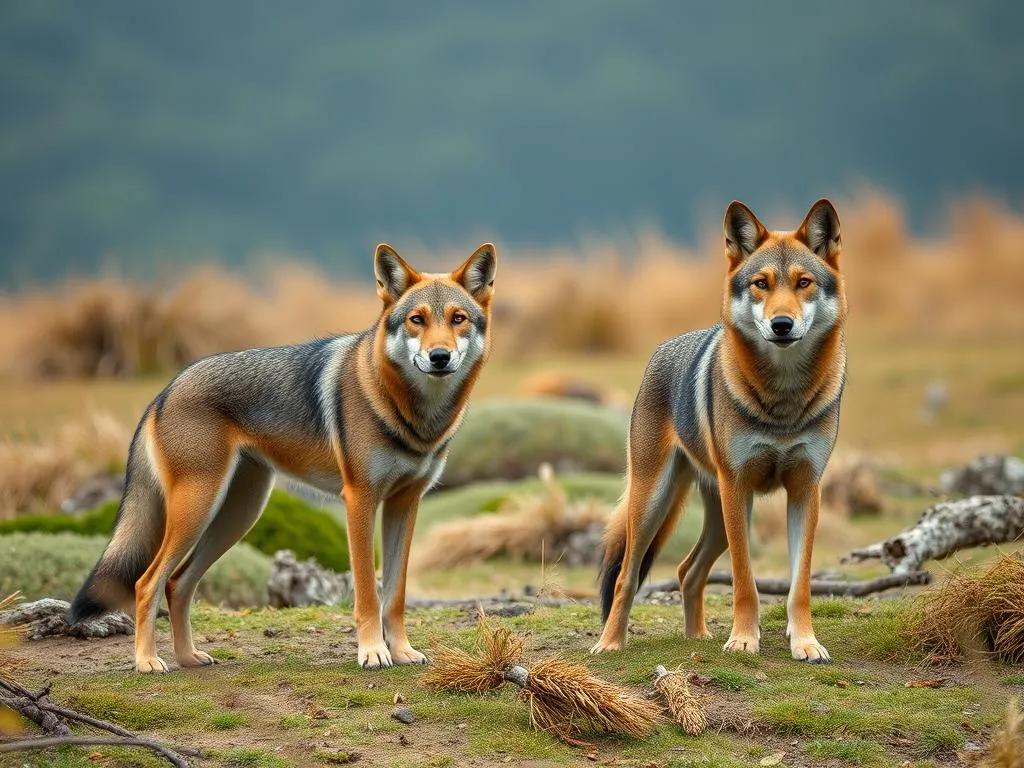
Introduction
Coyotes (Canis latrans) are fascinating creatures that inhabit a wide range of environments across North America. They are highly adaptable and can thrive in both rural and urban settings. Understanding these wild canids is essential not just for wildlife enthusiasts but also for pet owners who may encounter them.
In contrast, domestic dogs (Canis lupus familiaris) exhibit an incredible diversity of breeds and sizes, ranging from tiny Chihuahuas to massive Great Danes. This diversity can lead to questions about how big coyotes are compared to dogs.
Understanding the size differences between these two species is crucial for several reasons: it helps in assessing potential risks, enhances our appreciation of wildlife, and fosters responsible pet ownership. In this article, we will explore the size of coyotes compared to various dog breeds, delve into their physical characteristics, and discuss the implications of these differences.
Understanding Coyote Size
Physical Characteristics of Coyotes
Coyotes are medium-sized canids, typically weighing between 24 to 46 pounds (11 to 21 kg). Their height at the shoulder ranges from 21 to 24 inches (53 to 61 cm), while their length can reach up to 46 inches (117 cm) when including the tail.
In terms of coloration, coyotes usually have a mix of gray, brown, and tan fur, which helps them blend into their surroundings. Their fur is coarse, and they have a bushy tail that often has a black tip.
Comparison with Other Wild Canids
When comparing coyotes to other wild canids, such as wolves and foxes, we can see both similarities and differences. For instance, wolves are significantly larger, with adult males averaging 70 to 110 pounds (32 to 50 kg). In contrast, red foxes are much smaller than coyotes, typically weighing between 8 to 15 pounds (3.6 to 6.8 kg). Geographic variations also affect size; eastern coyotes, for example, tend to be larger than their western counterparts due to differences in habitat and available prey.
Understanding Dog Size
Overview of Domestic Dog Breeds
Domestic dogs come in a vast array of breeds, each with its own unique characteristics and size profiles. The American Kennel Club (AKC) classifies dogs into several categories based on size: toy, small, medium, large, and giant.
This classification highlights the significant size range within domestic dogs, making it essential to consider specific breeds when discussing size comparisons with coyotes.
Average Sizes of Common Breeds
Here’s a brief overview of the average sizes of a few common dog breeds:
- Chihuahua (Toy): Weight: 2 to 6 pounds (0.9 to 2.7 kg); Height: 5 to 8 inches (12 to 20 cm).
- Beagle (Small): Weight: 20 to 30 pounds (9 to 14 kg); Height: 13 to 15 inches (33 to 38 cm).
- Labrador Retriever (Large): Weight: 55 to 80 pounds (25 to 36 kg); Height: 21.5 to 24.5 inches (55 to 62 cm).
- Great Dane (Giant): Weight: 110 to 175 pounds (50 to 79 kg); Height: 28 to 34 inches (71 to 86 cm).
These examples illustrate the broad spectrum of dog sizes, emphasizing the need for careful comparison with coyotes.
Coyotes vs. Dogs: A Comparative Analysis
Size Comparison
When comparing the size of coyotes to that of domestic dogs, we observe some notable differences. On average, coyotes weigh between 24 to 46 pounds (11 to 21 kg), which puts them in a similar weight category as small to medium-sized dog breeds.
In contrast, larger breeds like the Labrador Retriever and Great Dane can easily surpass the weight of a coyote. Here’s a quick comparison of average sizes:
| Species | Average Weight | Average Height | Average Length |
|---|---|---|---|
| Coyote | 24-46 lbs | 21-24 inches | Up to 46 inches |
| Chihuahua | 2-6 lbs | 5-8 inches | 10-15 inches |
| Beagle | 20-30 lbs | 13-15 inches | 13-16 inches |
| Labrador | 55-80 lbs | 21.5-24.5 inches | 22-24 inches |
| Great Dane | 110-175 lbs | 28-34 inches | 30-34 inches |
This table illustrates that while coyotes are comparable in size to some dog breeds, they are significantly smaller than others, especially giant breeds.
Behavioral Aspects Related to Size
The size of an animal often influences its behavior and adaptability. Coyotes, being wild animals, have developed behaviors suited to their size and lifestyle. Their agility and endurance allow them to hunt effectively, and their size contributes to their ability to evade larger predators.
In contrast, the behavior of dogs can vary widely based on breed. Smaller breeds may be more agile but less capable of handling larger threats, whereas larger breeds may exhibit protective behaviors. Understanding these behavioral aspects can help dog owners better navigate their pets’ interactions with coyotes.
Factors Influencing Size
Genetics and Breeding
Genetics play a significant role in determining the size of both coyotes and domestic dogs. Coyotes have evolved in response to their environment, leading to variations in size based on geographic location.
In domestic dogs, selective breeding has produced a vast array of sizes and shapes. Breeders often prioritize specific traits, which can lead to extreme variations in size among different breeds. This selective breeding has resulted in some breeds being significantly larger or smaller than their wild ancestors.
Environmental Influences
Environmental factors also shape the size of coyotes. Habitat quality, prey availability, and competition with other predators can influence their growth. For instance, coyotes living in urban areas may have different size characteristics compared to those in rural settings due to varying food sources and human interactions.
Conversely, domesticated dogs are influenced by their living conditions, diet, and lifestyle. A dog’s size can be affected by whether it is a working dog, a companion animal, or bred for specific tasks.
Real-World Implications of Size Differences
Interactions Between Coyotes and Dogs
Size differences between coyotes and dogs have real-world implications, particularly in urban environments where both species may coexist. Dog owners should be aware of the potential risks when their pets encounter coyotes, which can be perceived as threats or competitors.
It is essential for dog owners to supervise their pets, especially in areas known for coyote activity. Keeping dogs leashed and ensuring they do not roam freely can help prevent potential conflicts.
Coyote Behavior in Urban vs. Rural Settings
Coyotes often adapt their behavior based on their environment. In urban settings, they may become more accustomed to human presence and may even scavenge for food. This adaptation can lead to increased interactions with dogs, raising safety concerns for pet owners.
Case studies have shown that coyotes may exhibit more aggressive behavior in urban areas where food sources are scarce. Understanding these behavioral patterns can help dog owners take preventative measures to ensure their pets’ safety.
Conclusion
In summary, understanding how big coyotes are compared to dogs is vital for both wildlife enthusiasts and pet owners. Coyotes are medium-sized canids that can be comparable in size to small and medium dog breeds, but they are significantly smaller than giant breeds.
Recognizing the implications of size differences can enhance safety awareness and promote responsible pet ownership. By respecting wildlife and understanding their behavior, we can foster a more harmonious coexistence between our pets and the natural world.
FAQs
How do coyotes compare in size to large dog breeds?
Coyotes are generally smaller than large dog breeds like the Labrador Retriever and Great Dane. Coyotes typically weigh between 24 to 46 pounds (11 to 21 kg), while large breeds can weigh significantly more.
Are coyotes dangerous to my dog?
Coyotes can pose a threat to small dogs, especially if they perceive them as prey. It’s essential to supervise pets and keep them on a leash in areas where coyotes are known to roam.
Do coyotes and dogs share similar behaviors?
While both species exhibit canid behaviors, their instincts can differ. Coyotes are wild animals with survival instincts, while dogs are domesticated and often depend on humans for safety and care.
Can I train my dog to avoid coyotes?
Training your dog to respond to commands and stay close can help prevent encounters with coyotes. Socialization and positive reinforcement can also aid in teaching your dog to be aware of its surroundings.
Understanding the size and behavior of coyotes compared to dogs can enrich our perspective on wildlife and improve our interactions with them.









